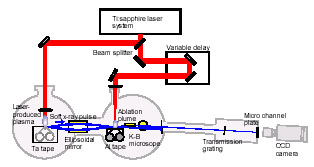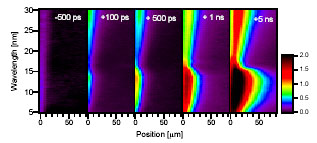Katsuya Oguri, Yasuaki Okano, Tadashi Nishikawa, and Hidetoshi Nakano
Optical Science Laboratory
Time-resolved x-ray measurement techniques have attracted much attention
as a result of the recent progress on the ultrashort x-ray pulse generation
technology based on laser-based x-ray sources and synchrotron radiation
sources. These techniques enable us to measure the ultrafast dynamics
of crystal structures, atomic distances, coordination numbers, and electronic
states in a highly nonequilibrium state, and they are expected to become
a key technique for the new interdisciplinary field linking conventional
x-ray science and ultrafast optical science, namely "ultrafast x-ray
science" [1].
We developed a spatiotemporally resolved XAS system by improving our
previous time resolved XAS system [2]. Using the system, we measured
the space and time evolution of a plume generated by the femtosecond-laser-ablation
process, which is expected to become a new laser-processing technique [3].
We demonstrated that the system is a powerful tool for probing the
complicated phenomenon that evolves temporally and spatially with the solid
to liquid to gas phase transition, and the dissociation of chemical bonding
[4].
The most noteworthy characteristic of our system is that it combines
the short pulse duration of femtosecond laser plasma soft x-rays and the
high spatial resolution of the Kirkpatrick-Baez microscope, thus considerably
improving the temporal and spatial resolution, and the soft x-ray flux
on a sample. The soft x-ray microscope and a transmission grating
simultaneously provide us with spectral information and one-dimensional
spatial information of an expanding laser ablation plume (Fig. 1). Figure
2 shows the temporal evolution of a spatially resolved absorbance spectrum
for an Al ablation plume induced by 100-fs laser irradiation with an intensity
of 1.5×1014 W/cm2. This figure clearly shows that the Al ablation plume expands from
the Al tape surface toward the vacuum with time. The most remarkable
feature of the ablation plume is the significant shift of the LII,III absorption edge towards a shorter wavelength compared with that of solid
Al. Since the wavelength of the LII,III absorption edge of
the ablation plume corresponds to the transition energy from the 2p state to continuum states, the edge shift depends on each particle constituting
the ablation plume. This result demonstrates that our system is a
powerful tool for measuring the dynamics of laser ablation plumes.
[1] Bressler and Chergui, Chem. Rev. 104 (2004) 1781.
[2] Oguri, et al., Appl. Phys. Lett. 87 (2005) 011503.
[3] Okano, et al., Rev. Sci. Instrum. 77 (2006) 046105.
[4] Okano, et al., Appl. Phys. Lett. 89 (2006) 221502.
 |
 |
|||||
|
|